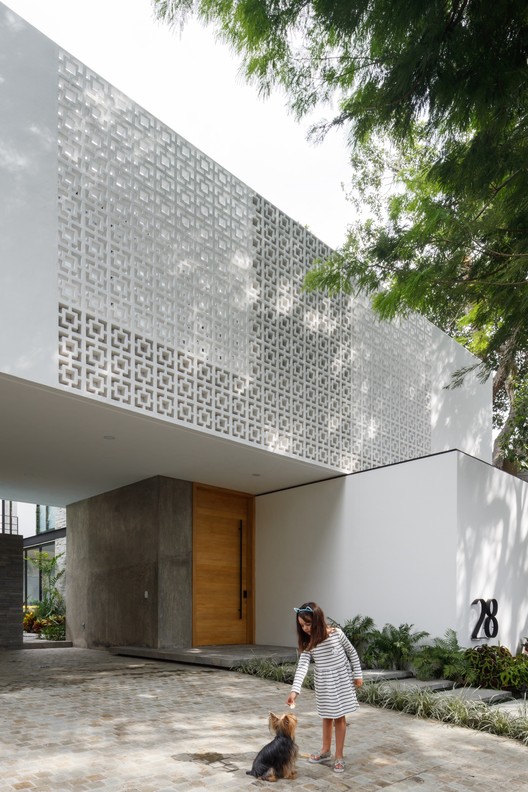Maillen Hotel And Apartment Urbanus
2012-02-23 00:00
架构师提供的文本描述。在中国,当代住宅设计通常遵循一个专注于房地产的公式,以限制市场风险。因此,在这种市场导向的现实中,建筑师很难找到机会和空间来开发新的住房类型。
Text description provided by the architects. Contemporary housing design in China usually follows a preoccupied real estate formula to limit risk in the market. As a result, it is hard to find opportunities and space for architects to develop new housing typologies in such market-oriented reality.
© Wu Qiwei
(三)吴其伟


该项目位于深圳市蛇口区的一个山坡上,总建筑面积约为13200平方米,建筑面积为25100平方米,用于居住公寓和酒店客房。本项目的目的是对中国传统的房地产开发提出质疑,因为只有设计才是如何节约项目,而不是对空间质量进行深入的建筑设计。
Located on a hillside at Shekou district in Shenzhen, the total area of the project site is roughly 13,200 square meters, with 25,100 square meters of built area for residential apartments and hotel rooms. The intention of this project is to question the conventional real estate developments in China, for which only design is only about how to economize the project instead of in-depth architectural design of spatial quality.
© Wu Qiwei
(三)吴其伟


与此形成对比的是,本课题的核心概念是如何将建筑与现有的地理条件结合起来,回忆中国传统园林在现代生活空间创造中的经验,从而从传统的中国重新诠释日常生活体验和空间组织。因此,梅伦酒店
Contrasting to that, the key concept of this project focuses on how to contextualize architecture with the existing geographical condition and to recall the experience of traditional Chinese gardens in the making of modern living space, thus to reinterpret the everyday life experience and spatial organization from traditional China. As a result, the Maillen Hotel & Apartment becomes an special living environment for both short and long term tenants. The proposal offers an alternative to the typical models of housing development. In addition, it allows sufficient profits and increases local job opportunities.
该项目通过强调“山外山,花园在崖中”的经验,记住了一些关于景观的基本哲学思想。中国传统哲学通常通过山/水、园林/树的隐喻和辩证关系来想象人与自然之间的唯心主义。考虑到这些概念,设计师们想要创造一种新的生活方式,将传统的居住和景观理论与当代生活方式结合起来。内部空间组织设计得很好:当一个人沿着路径在复杂的内部行走时,就会产生一种线性和持续的体验。时间观念的重点是模仿中国传统乡村景观空间体验的节奏。
The project remembers some fundamental philosophical ideas of landscape by emphasizing the experience of ‘hills outside hills, and gardens inside gardens.’ Chinese traditional philosophy usually imagines the idealism between man and nature by using the metaphorical and dialectic relationship of hill/water and garden/trees. With these concepts in mind, designers would like to create a novel life style, which integrates traditional dwelling and landscape theory and contemporary lifestyle. The internal spatial organization is well designed: a linear and continuous experience is engendered when one is walking inside the complex following the pathways. The emphasis of the idea of time is an attempt to mimic the rhythm of the spatial experience of traditional villages and landscapes in China.
elevation 01
elevation 01


位于山脚,名为“南山”,是一个梯田和斜坡之一。建筑综合体以矩形几何形式从景观中缓缓生长,以适应地理环境。池塘和庭院提供给居民回忆自然的经验,在人造的。从单位的视野延伸到较小的庭院,在那里可以找到竹子、松树和梅花。在建筑群的中心,水面上漂浮着一条小小的人行道,连接着相互连接的花园。
Located on the foot of the hill, called ‘Nan Shan’, the site is a terraced and sloped one. The building complex gently grows from the landscape in rectangular geometry, to respond to the geography. Ponds and courtyards are offered to the residents to recall the experience of the nature in the manmade. Views from the units extend to smaller courtyards, where bamboo, pine, and plum blossom can be found. In the center of the complex, a modest walkway forms floating on the water, bridging the interconnected gardens.


































































Architects Urbanus
Location Yanshan Road, Shekou, Nanshan District, Shenzhen, China
Category Apartments
Principle Architect Meng Yan
Project architects Huang Zhiyi, Yao Xiaowei, Zheng Ying | Xing Guo, Wei Zhijiao (Landscape)
Team Zuo Lei, Liu Xiaoqiang, Ye Peijun, Li Da, Shen Yandan, Ji Yuyu, Zhang Zhen, Liu liu, Xia Miao, Xiong Huijing (Architecture) | Ding Yu, Cedric Yu, Li Jing, Huang Yihong, Liao Zhixiong (Landscape) | Zhu Jialin (Technical Director)
Project Period 2005-2011
Site Area 13,198 ㎡
Floor Area 21,540 ㎡
Photographs Wu Qiwei
























